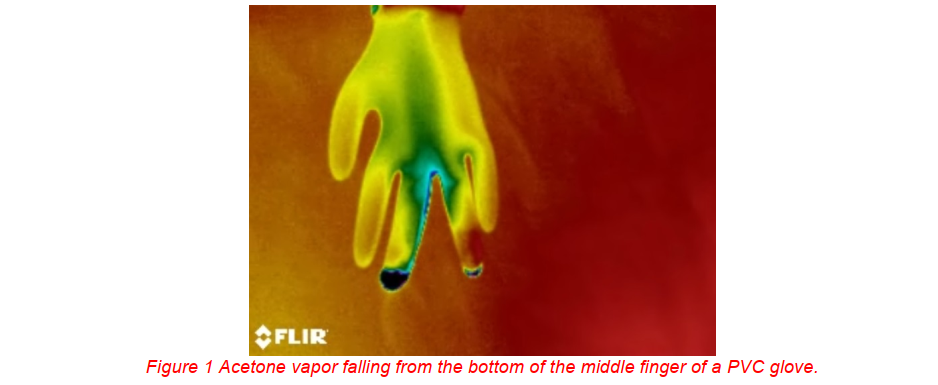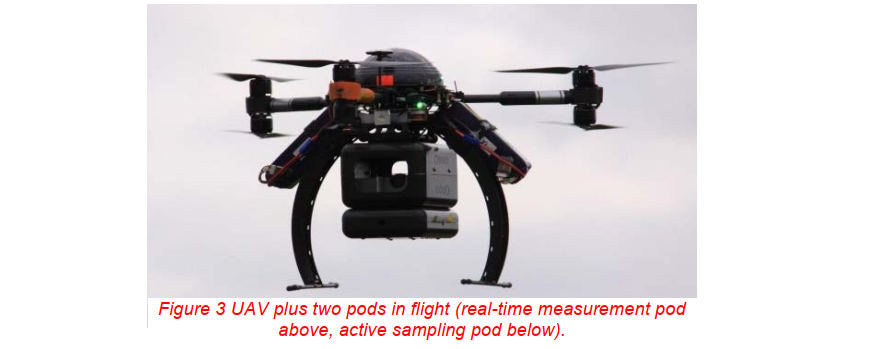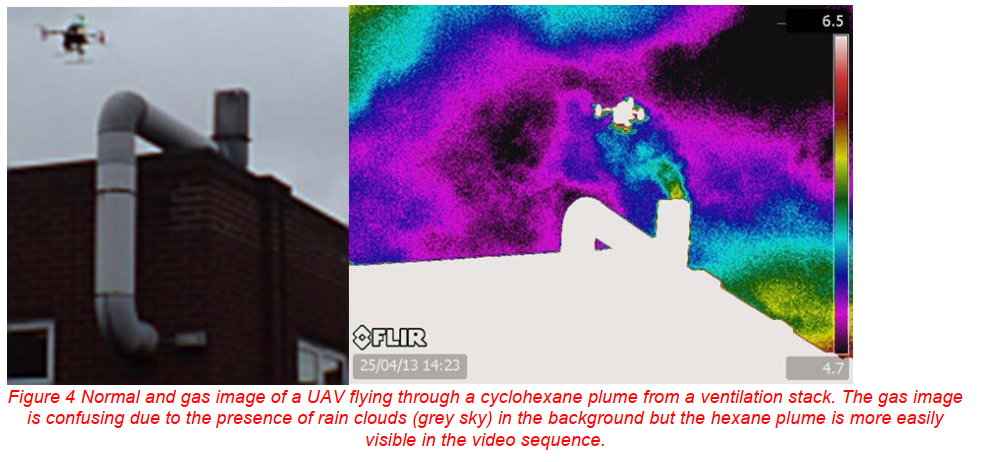Use of an Optical Gas Imaging Camera at the UK’s HSE including work with an UAV for LEV stack Analysis

InfraMation 2018 Application Paper Submission
Mike Hemingway PhD CPhys MIoP
Health & Safety Executive, UK
ABSTRACT
The FLIR GF320 Optical Gas Imaging Camera [1] has been used by the UK’s Health and Safety Executive (HSE) to visualize gas plumes including major natural gas, hexane and liquid nitrogen releases and to visualize glove permeation. This work was extended to determine the camera’s usefulness when using an Unmanned Aerial Vehicle (UAV) to improve HSE’s incident analysis capability and, in particular, to measure organic pollutants from Local Exhaust Ventilation (LEV) stacks. Initially, the camera was used on the ground to identify problem exhaust stacks and then the camera operator could provide instructions to an UAV pilot to guide it to exhaust plumes from the stacks of interest. This allowed quantifiable aerial pollutant air concentration measurements to be made using more conventional onboard real-time detectors or pumped samplers for later analysis. Additional tests were carried out in which the camera was carried by a larger UAV so that the pilot could guide it directly to areas of interest, without the need of instructions provided by a separate camera operator.
The possibility of air-based surveys of gas plumes using the Optical Gas Imaging camera on-board a UAV has been established although the technique needs to be improved by integrating remote control capability with the UAV control system and quantitative gas imaging techniques.
INTRODUCTION
The use of FLIR gas imaging systems for the location and repair of gas or volatile organic compound (VOC) leaks is well understood and documented [1]. The FLIR GF320 for visualizing methane and VOC is designed to visualize leaks at percentage level concentrations. This has proved useful at the HSE for visualizing large scale gas plumes, but the camera may also be effective in other applications for the HSE such as very small-scale plumes or the much lower concentrations that are commonly uncounted in incident investigation and occupational hygiene work. Some of this work is detailed and includes small scale VOCs (glove permeation), medium-scale or low concentration VOC plumes (local exhaust ventilation of hexane) and large-scale hexane releases.
GLOVE PERMEATION VISUALIZATION
The permeation of potentially dangerous substances through safety gloves and other material is well understood, but it is not a well-known phenomenon amongst the general public. To improve public awareness a video showing how volatile organic compounds can pass through gloves was commissioned using the FLIR gas imaging camera. As the camera cannot see inside the gloves small samples of acetone were injected into inflated gloves and vapor could be clearly seen moving out of the gloves, see Figure 1. This proved effective in improving the awareness of the potential problem and is used in HSE training programs.


Following an explosion at a UK oil storage depot HSE investigated the flow and evaporation of large volumes of volatile liquids in order to better understand how an explosive cloud of vapor can form [2]. A gas imaging camera was used to show how vapor clouds are developed from large volume flows of volatile liquids (17.6 kg.s-1 hexane) and how instabilities in the flow could generate unexpected turbulence that produced a much larger cloud than previously thought, see Figure 2.
HSE’S UNMANNED AERIAL VEHICLE CAPABILITY
Unmanned aerial vehicle equipment was developed in support of the work of the HSE and to produce a practical and validated solution for potential measurement requirements in difficult to access environments as well as one that would integrate with existing services to safely provide new evidential data. The collection of this data would not only safely mirror that of existing equipment, but potentially provide a whole new perspective through visualisation of the incident location and make available supplementary measurement data from these difficult to access environments. A range of tests were carried out to demonstrate and record this capability. The UAV sampler method was shown to provide a qualitative (or semi-quantitative) measure of some hazardous airborne materials and this information was combined with video imagery to provide additional information to indicate likely potential hazards and provide additional confidence for ground-based staff to enter and take traditional samples. Several independently powered interchangeable carbon fibre pods were developed that could be mounted on any suitable UAV (Figure 3). New and customised UAV are continually coming on to the market and the modular system also allows for easy transfer to these newer UAVs. The primary components of this versatile and adaptable system comprised:
Risk assessed UAV operation by professional contractors with Civil Aviation Authority approval
Bioaerosol particle counting, e.g. for Legionella
Sampling for respirable fibres, e.g. silica, asbestos
Tedlar bag bulk gas sampling
Colorimetric tube sampling, e.g. first response by non-skilled personnel
Air sample collection for later analysis and speciation, e.g. volatile organic compounds (VOC), fibres, and isocyanate
Air sampling in real time, e.g. for total VOC and H2S
Live data down load to Exposure Level Visualisation
Data Logging
Waypoint tracking
Secure encryption of data down-link
Flight control was manual or by pre-set waypoint flight controlled from an iPad for grid searching and mapping. As UAVs are not intrinsically safe on-board measurement of volatile organic chemicals through use of lower explosive limit (LEL) sensors or photo-ionisation detectors allows warning of elevated vapor concentrations enabling rapid stand-off from potentially unstable atmospheres

Preliminary testing evaluated the impact of changes in air velocity generated by the rotors of the UAV during flight and showed no significant impact on the reliability or accuracy of the measurements obtained. It is therefore safe to assume that the results of any test would be equal to those obtained if it was possible for a person to directly operate conventional sampling equipment at that same location at the same time. It has also been shown that this data can be sent back to the pilot and ground based technical team in real time from a distance that exceeds the range permitted to fly.
TARGETING OF VAPOR PLUMES USING GROUND BASED GAS IMAGING
The gas imaging camera has been designed to locate hidden organic vapor plumes. Therefore, it can be used to locate and guide the HSE’s UAVs into a plume to collect air samples for measurement, see Figure 4.

Having manoeuvred the UAV into the sampling zone, real-time feedback of the data allows instant measurement of any VOC or other gases present, providing the appropriate instruments are mounted on the UAV. With this confirmation the much more sensitive and discriminating sorbent tubes can be used to collect air samples for further analysis. This whole process ensures that the sample collected on these tubes is very likely to contain the substances of interest, and consequently that the collected samples will provide a true representation of the plume gases or vapors, rather than the adjacent clear air. The primary limiting issue relates to the size of the plume and concentration of the vapor; a small, diffuse low concentration vapor release remains a challenge. Other relevant factors include the background contrast and the importance of avoiding water (rain) from contaminating the lens. Despite these drawbacks the FLIR proved effective in all but the most challenging scenarios tested except when there was too much wind, which dissipated the vapor plume too quickly (and also made UAV flight difficult), or sunlight reflected off metal structures dazzled the camera, making it less sensitive.
SEARCHING FOR VAPOR RELEASE SOURCES USING ON-BOARD GAS IMAGING
Once the UAV had been developed to carry heavier loads, the gas imaging camera was attached to it and then flown, whilst its gas image was transmitted directly to the UAV pilot’s control equipment. This allowed the pilot to guide the UAV to search for vapor releases directly, without the need of a separate gas imaging operator. The GIC made small butane and alcohol releases visible. However, on a trial of a methane release from a metal tower, the plume could not be seen because there was too much wind. Additionally, the metal tower reflected bright sunlight, which made it appear to be hot thus dazzling the GIC and making it less sensitive, see Figure 6a. However, when the trial was repeated on a day with less wind and no direct sunlight on the tower the gas plume could be easily identified, see Figure 6b. A disadvantage of the present GIC system is that it cannot be adjusted during flight, making it more difficult to locate a vapor plume (typically the best settings, particularly the point of focus and gas sensitivity, need to be estimated before a flight). A real-time adjustment of the GIC during a flight would enable its sensitivity to be tailored to match the current viewing conditions and this feature may have made the vapor release in Figure 5a visible. However, this limitation could be removed as a relatively recent software update has added remote control capability to the gas imaging system [3], although it would need integration with the UAV control system.

REFERENCES
|
[1] |
FLIR Systems, “FLIR Gas Detection Systems,” 2018. [Online]. [Accessed July 2018]. |
|
[2] |
B. M. I. I. Board, Buncefield: Why did it happen? The underlying causes of the explosion and fire at |
|
[3] |
FLIR Systems, “FLIR Tools+,” 2017. |
ACKNOWLEDGEMENTS
The author wishes to thank Neil Plant and Rodger Clark for their work on the UAV system and to ArialVue for providing the UAVs and pilots.
ABOUT THE AUTHOR
Dr Hemingway is a Senior Scientist in the UK's Health and Safety Laboratory which provides research facilities and technical expertise primarily for UK's Health and Safety Executive (HSE) but also for a wide range of other public and private-sector organizations. His work is principally concerned with the applications of real-time instrumentation for the measurement of toxic and flammable gas and dusts in both the Major Hazards and Occupational Hygiene fields. His work has included personal gas monitoring, FTIR and IR gas detection, gas imaging, mine fire detection and optimization of gas detector networks and locations.